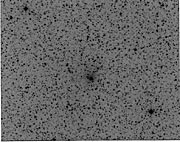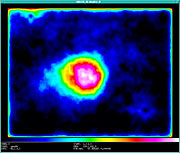Press Release
The Enormous Size of Comet Hale-Bopp
30 August 1995
This series of three photos of the unusual Comet Hale-Bopp demonstrates that the comet is much larger than thought so far. In fact, its nucleus is surrounded by a dust cloud that measures more than 2.5 million kilometres across. Note that because of the wide field they represent, each of the images is available in two sizes, the larger of which has considerably better resolution.
They are based on a wide-field photographic plate obtained by Guido Pizarro, Patrice Bouchet and Jean Luc Beuzit (ESO) with the 1-metre Schmidt telescope at the La Silla observatory on August 18.1 (UT). The exposure lasted 30 min and was made on sensitized Kodak IIIa-F emulsion through a red RG630 filtre. This combination registers light in the 6300 - 7000 A (630 - 700 nm) spectral region and is well suited to show the sunlight reflected from the dust particles in the coma of Comet Hale-Bopp.
Each of the three photos covers the same sky area of approx. 25 x 20 arcminutes; the scale is indicated on ESO Press Photo eso9521 by a 5 arcminute bar. North is up and East is to the left. At the time of this exposure, the comet was located in a very rich stellar field in the constellation of Sagittarius (R.A. = 18 hrs 27.7 min; Decl. = -31 deg 18 min ; equinox 2000.0), and less than 10 degrees from the direction of the galactic centre. The distances from the Earth and the Sun were 930 and 1040 million kilometres, respectively.
ESO Press Photo eso9521a is a direct photographic reproduction of the (negative) original Schmidt plate, made through an intermediate (positive) film in order to show the star field and the comet exactly as they look on the original plate. The diffuse image of the comet is situated at the centre. The comet moved 8 arcsec towards West and 3 arcsec towards North during the exposure.
In order to better show the real extent of the surrounding coma, ESO Press Photo eso9521b displays a photographically enhanced copy of the original plate. In this process, the contrast has been greatly increased so that even very faint areas of the diffuse coma become visible. The comet now appears as a roughly circular, dark object in the front of myriads of stars in this sky area. Its angular size is at least 5 arcminutes, much larger than on the direct reproduction (eso9521a). There also seems to be a very faint extension towards East (left).
The last image, ESO Press Photo eso9521c carries this process one step further by a successive use of photographic enhancement and subtraction, followed by smoothing by computer processing . When a matching, earlier exposure of the same sky field with the same telescope (on which the comet is not present) is photographically subtracted from the enhanced photo (eso9521b), then the images of the stars should in principle cancel out, leaving only that of the comet in the field. A full cancellation is virtually impossible to achieve in practice, but if the resulting image is heavily smoothed (i.e., substituting each image element with the mean intensity of its surroundings), then the smaller images of the stars disappear and the full extent of the comet's large coma becomes visible.
This false-colour photo was produced in this way by means of computer processing within the MIDAS image processing system. The images of the brightest stars could not be completely removed by this process and faint remnants are still present. (In technical terms, a 2-D low-pass Fourier filter was used to achieve heavy smoothing over approx. 16 x 16 arcsec cells).
The elongated structure of the outer coma of Comet Hale-Bopp is now well visible. As can be seen, the North-South extension is almost 8 arcminutes, while that in the East-West direction is above 10 arcminutes. The extension towards East (left) is positioned in the direction opposite to the projected direction towards the Sun. It is therefore most likely the rudiments of a usual cometary dust tail, i.e. dust particles that have been pushed away from the inner coma by the pressure of the sunlight. There also appears to be some structure in the brightest part of the coma. The location in this coma of the point of maximum brightness in which the comet's nucleus is imbedded may be perceived by a comparison between Photos 24A and 24C.
At the distance of the comet, 1 arcminute corresponds to a projected distance of about 270,000 kilometres, and the coma here visible thus measures no less than 2.1 x 2.7 million kilometres. This is an enormous size for a comet at this distance and it illustrates the degree of the present activity.
The photographic work and the computer processing were made by Hans-Hermann Heyer, Ed Janssen and Hans-Ulrich Kaeufl at ESO-Garching. A related announcement was made on IAU Circular 6216 of August 29, 1995.
ESO Press Photos may be reproduced, if credit is given to the European Southern Observatory.
About the Release
| Release No.: | eso9521 |
| Legacy ID: | Photo 24a-c/95 |
| Name: | Comet Hale-Bopp |
| Type: | Solar System Solar System : Interplanetary Body : Comet |
| Facility: | ESO 1-metre Schmidt telescope |
Our use of Cookies
We use cookies that are essential for accessing our websites and using our services. We also use cookies to analyse, measure and improve our websites’ performance, to enable content sharing via social media and to display media content hosted on third-party platforms.
ESO Cookies Policy
The European Organisation for Astronomical Research in the Southern Hemisphere (ESO) is the pre-eminent intergovernmental science and technology organisation in astronomy. It carries out an ambitious programme focused on the design, construction and operation of powerful ground-based observing facilities for astronomy.
This Cookies Policy is intended to provide clarity by outlining the cookies used on the ESO public websites, their functions, the options you have for controlling them, and the ways you can contact us for additional details.
What are cookies?
Cookies are small pieces of data stored on your device by websites you visit. They serve various purposes, such as remembering login credentials and preferences and enhance your browsing experience.
Categories of cookies we use
Essential cookies (always active): These cookies are strictly necessary for the proper functioning of our website. Without these cookies, the website cannot operate correctly, and certain services, such as logging in or accessing secure areas, may not be available; because they are essential for the website’s operation, they cannot be disabled.
Functional Cookies: These cookies enhance your browsing experience by enabling additional features and personalization, such as remembering your preferences and settings. While not strictly necessary for the website to function, they improve usability and convenience; these cookies are only placed if you provide your consent.
Analytics cookies: These cookies collect information about how visitors interact with our website, such as which pages are visited most often and how users navigate the site. This data helps us improve website performance, optimize content, and enhance the user experience; these cookies are only placed if you provide your consent. We use the following analytics cookies.
Matomo Cookies:
This website uses Matomo (formerly Piwik), an open source software which enables the statistical analysis of website visits. Matomo uses cookies (text files) which are saved on your computer and which allow us to analyze how you use our website. The website user information generated by the cookies will only be saved on the servers of our IT Department. We use this information to analyze www.eso.org visits and to prepare reports on website activities. These data will not be disclosed to third parties.
On behalf of ESO, Matomo will use this information for the purpose of evaluating your use of the website, compiling reports on website activity and providing other services relating to website activity and internet usage.
Matomo cookies settings:
Additional Third-party cookies on ESO websites: some of our pages display content from external providers, e.g. YouTube.
Such third-party services are outside of ESO control and may, at any time, change their terms of service, use of cookies, etc.
YouTube: Some videos on the ESO website are embedded from ESO’s official YouTube channel. We have enabled YouTube’s privacy-enhanced mode, meaning that no cookies are set unless the user actively clicks on the video to play it. Additionally, in this mode, YouTube does not store any personally identifiable cookie data for embedded video playbacks. For more details, please refer to YouTube’s embedding videos information page.
Cookies can also be classified based on the following elements.
Regarding the domain, there are:
- First-party cookies, set by the website you are currently visiting. They are stored by the same domain that you are browsing and are used to enhance your experience on that site;
- Third-party cookies, set by a domain other than the one you are currently visiting.
As for their duration, cookies can be:
- Browser-session cookies, which are deleted when the user closes the browser;
- Stored cookies, which stay on the user's device for a predetermined period of time.
How to manage cookies
Cookie settings: You can modify your cookie choices for the ESO webpages at any time by clicking on the link Cookie settings at the bottom of any page.
In your browser: If you wish to delete cookies or instruct your browser to delete or block cookies by default, please visit the help pages of your browser:
Please be aware that if you delete or decline cookies, certain functionalities of our website may be not be available and your browsing experience may be affected.
You can set most browsers to prevent any cookies being placed on your device, but you may then have to manually adjust some preferences every time you visit a site/page. And some services and functionalities may not work properly at all (e.g. profile logging-in, shop check out).
Updates to the ESO Cookies Policy
The ESO Cookies Policy may be subject to future updates, which will be made available on this page.
Additional information
For any queries related to cookies, please contact: pdprATesoDOTorg.
As ESO public webpages are managed by our Department of Communication, your questions will be dealt with the support of the said Department.



